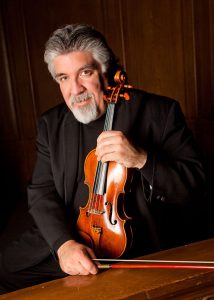
By Dennis D. Rooney
A modest audience, socially distanced, heard a program Jan. 8 of Paganini, Vivaldi and Schubert played by 25 members of The Symphonia under the direction of Andrés Cárdenes, the co-founder and artistic and music director of the Josef Gingold Chamber Music Festival of Miami, a program geared toward educating young musicians. He is also on the faculty of Pittsburgh’s Carnegie-Mellon School of Music.
Some misguided soul in the Symphonia’s marketing department decided to entitle the program “Sizzling Strings.” The players didn’t exactly sizzle, although they obviously were diligent in their preparation. However, the tonal balance among the choirs in the Roberts Theater at St. Andrew’s School in Boca Raton was a bit lopsided, with the violins rather astringent in tone while violas, cellos and basses offered a compensating warmth.
A world premiere opened the program, a string orchestra version of the Variations on Paganini’s Caprice No. 24 (1982) by the contemporary Mexican violist and composer Javier Montiel. In his prefatory remarks, Cárdenes informed us that the composer originally conceived his arrangement of Paganini’s solo violin original as a string quartet but later enlarged it at Cárdenes’s suggestion. The larger body of strings imparted an obvious rhythmic character that the original solo version does not. Whereas a performance of the latter seeks to erase a sense of bar lines, the enlargement emphasizes them to a quite different effect.
The two Vivaldi concerti that followed came from La Stravaganza (Eccentricity), a set of 12 composed between 1712-1713 and published in 1716 as the composer’s Opus 4. Cárdenes led his players in pleasing performances of No. 2 in E minor, R. 279, and No. 11 in D, R. 209. As I watched him play, I was struck by his strong resemblance to Eugène Ysaÿe, the Belgian virtuoso. The impression was primarily physical, although Ysaÿe is also a true violinistic ancestor of Cárdenes, descended through his teacher, Josef Gingold, one of Ysaÿe’s late pupils.
Like most of Vivaldi’s 500+ concerted works, they were written for performance by the orphan girls whom he trained at Venice’s Ospedale della Pietà, which evidently numbered some extraordinary players. The virtuosity of the institution’s all-female ensembles attracted tourists from throughout Europe. Despite a diligent exploitation of tonic-dominant relationships that reinforced the shift in harmonic organization from modality to tonality then underway, Vivaldi still managed astonishing melodic, rhythmic, and textural variety. The opening Allegro of the E minor Concerto and the Largo and Allegro assai of the D Major were particularly interesting to these ears.
With no intermission, the players concluded the program with Gustav Mahler’s 1894 arrangement of Franz Schubert’s Quartet No. 14 in D minor, D. 810, which is nicknamed “Death and the Maiden” because its second movement is a theme and five variations on Schubert’s earlier Lied, “Der Tod und Das Mädchen,” of 1817.
The quartet dates from 1824 and is his penultimate work in the form. Its intensely dramatic outer movements (sonata and a rondo à la tarantella, respectively) and the character of the slow movement contrast with a scherzo whose trio contains the only major-mode music in the score. Although it was performed in Schubert’s lifetime, it was not published until 1831, after which the quartet gradually became firmly lodged with the quartets of Haydn, Mozart and Beethoven as among the greatest of all works in the genre.
Maher completed his arrangement of Schubert’s second movement and left directions for the others, but they remained unfinished at his death. Completed by David Matthews and Donald Mitchell, the entire arrangement was first heard in 1984. I found it of variable interest. The most passionate utterances in the outer movements benefited from a larger body of strings; elsewhere, however, one remained convinced that four players remain the most successful advocates of the music’s essence.